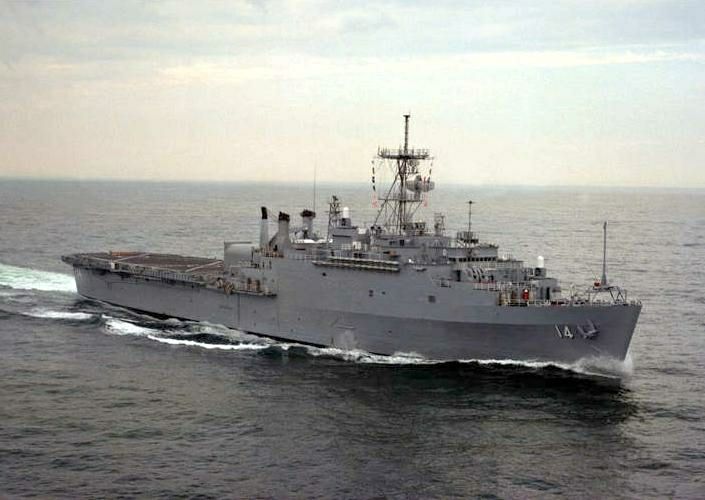|
New
Delhi, 09 August 2005

Warming
up of Indo−US
ties has opened up several possibilities in the
mutual defence relationship. If recent press reports
are to be believed the Indian Navy is eyeing the USS
Trenton a
landing platform dock (LPD), which is scheduled to
be decommissioned by the US Navy in 2008.
Dock
Landing Ships were developed during World War II as
a means of transporting landing crafts (a large
proportion of the hull of this type of craft is a
floodable docking well), across the open seas and
launching them in an assault on an enemy
coast. These ships constituted a vital part of
the allied assaults on D Day landings and in other
theaters. LPDs are still operated by major navies
around the world and range from the USN’s latest ‘Whidbey
Island’ Class to RN’s ‘Fearless’
Class and the Russian ‘Ivan
Rogov’.
An
‘Austin’ class design, ‘Trenton’
(LPD14) is one of the older LPD classes now on the
verge of being decommissioned. It was built by
Lockheed Shipbuilding & Construction Co. and
commissioned into service in March 1971. Vital
statistics include a length of 173.4 meters, beam of
32 meters and a maximum displacement of 16914 tons.
Two Foster Wheeler boilers, powering two De Laval GT
turbines, driving two propellers provide a total of
24000 SHP to propel it to a max speed of 21 knots.
The
ship is configured as a flagship and provides
extensive command, control and communications
facilities to support an Amphibious Task Force and
Landing Force. In an amphibious assault, the ship
normally functions as the Primary Control Ship that
would be responsible for coordinating and vectoring
landing craft to the beach. The ships can carry one
landing craft air cushion (LCAC), or one utility
landing craft (LCU) boat, or 24 amphibious assault
vehicles (AAV), up to six medium helos and over 800
combat troops. To facilitate the docking and loading
of various sized landing craft, the ship can ballast
down in the water, thereby flooding the well deck to
enable the landing craft to enter or exit the well
deck through the stern gate door. The well decks
have upper and lower vehicle storage areas, which
hold most of the embarked troops' heavy combat
equipment, such as tanks, tracked amphibious landing
vehicles (AAV), jeeps and trucks. A large helicopter
platform is built over the well deck in the rear of
the vessel with two landing spots. Alternatively the
ship can also act as an attack cargo ship carrying
2,000 tons of supplies and equipment. The electronic
sensor suite comprises AN-SPS-40/SPS-60 air/surface
search radar and SPS-64 navigation radar. Self
defence is provided by two 25mm guns, two Phalanx
CIWS and assorted machine guns.
A
secondary mission is evacuation and civilian
disaster relief, which can be of immense help in
effectively managing Tsunami like natural
calamities. In such a role, hundreds of tons of
relief materials can be carried aboard and can be
delivered to disaster victims very quickly by
integral boats and deck launched helicopters. The
ship also has a small hospital on board with limited
berthing to treat the sick and injured.
All
in all this is a very capable ship suitable for
power projection in littoral regions with an ability
to transport and launch powerful expeditionary
forces. It also has an equally vital and relevant
disaster relief role and would be a great asset for
the IN. The only limiting factor is the elderly age
of the class. The ‘Trenton’
itself is more than 30 years old and a proposed
refit in 1988 was never done. However ships of this
class have usually seen 4 decades and more of
service in the USN and it would no doubt be
extensively refitted for considerable life extension
prior to the transfer.
Sources:
www.fas.org
http://navysite.de
|